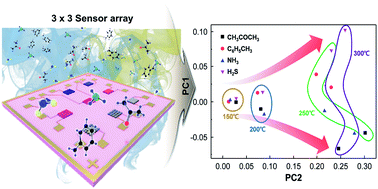High-performance gas sensor array for indoor air quality monitoring: the role of Au nanoparticles on WO3, SnO2, and NiO-based gas sensors†
Abstract
With the increasing demands of indoor air quality monitoring, highly sensitive and selective gas sensor arrays consisting of metal oxide semiconductors have been increasingly studied. As an effective strategy to obtain the desired performance, noble metal functionalization is frequently chosen owing to its target-specific sensing mechanisms. However, the lack of a comprehensive analysis on the sensing mechanisms of different combinations of metal oxides and noble metals limit the versatility of these sensor arrays for use in selective gas sensor arrays. In this study, we fabricate a 3 × 3 gas sensor array to obtain a reliable comparison of the sensing mechanism through the use of three metal oxides—WO3, SnO2 and NiO—in three different nanostructure forms: a thin film and dome-like nanostructures with and without Au nanoparticle (NP) decoration. The responses of the sensor arrays to four target gases (CH3COCH3, C6H5CH3, NH3, and H2S) are generally enhanced by the dome-like nanostructure and show distinctively enhanced responses when the sensors are decorated with Au NPs. Moreover, the dome-like SnO2 with Au NPs shows an increase of up to 121 times for C6H5CH3 compared with the pristine SnO2 thin film. Additionally, the sensitization effects of Au NPs depend on the types of metal oxides and gases, which improve the gas discrimination capability by diversifying the gas selectivity of the sensor units in the array. The prepared sensor array can distinguish four target gases by principal component analysis (PCA). The contributions of different enhancement mechanisms, which are dependent on the gases and metal oxides, are investigated by comparing the activation energy of each gas response with and without Au. The comparison among the chosen gases reveals that the decoration of Au NPs is effective for C6H5CH3 and NH3 regardless of the type of metal oxide. Among the metal oxides, the effects of Au NPs on gas responses are in the order of SnO2, NiO, and WO3, in which the energy level difference between the Au NPs and metal oxide are 0.2, 0.1, and −0.6 eV, respectively. These results confirm that the dominant enhancement mechanism of Au NPs for each combination of gases and metal oxide is a decrease in activation energy. Therefore, this study provides a systematic understanding of the sensitization mechanism of Au NPs on metal oxides toward gases for the fabrication of selective gas sensor arrays.

- This article is part of the themed collection: 2021 Journal of Materials Chemistry A most popular articles


 Please wait while we load your content...
Please wait while we load your content...